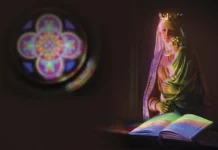What is the meaning of the adornments that this maiden wears to please her husband and King? We do not find these details in Sacred Scripture, but in a beautiful medieval Gregorian hymn.

Royal Convent of the Immaculate Conception – Quito, Ecuador
“Hear, O daughter, consider, and incline your ear; forget your people and your father’s house; and the king will desire your beauty. Since he is your lord, bow to him […] The princess is decked in her chamber with gold-woven robes; in many-coloured robes she is led to the king” (Ps 45:10-11, 13-14). And delighted by her beauty, he says: “I will cause your name to be celebrated in all generations; therefore the peoples will praise you for ever and ever” (Ps 45:17).
The psalmist narrates a festive scene: the marriage between a mysterious king who is fair to behold and eloquent, a defender of justice and lover of truth, and a beautiful princess. It evokes splendid chambers, joyful singing, rich perfumes and garments, an entourage of virgins, and gifts from monarchs
This psalm highlights the figure of the “beautiful princess” who enters the royal palace at a slow pace. Giving herself to the king in perpetual matrimony, she becomes the mother of numerous offspring and receives, through this bond, a royal inheritance.
The pious soul will easily associate this gracious queen with the noble Virgin, called to be united with the Supreme King. Few, however, will have paid attention to the “many-coloured robes” of which the psalmist speaks, and which, like everything pertaining to the Blessed Virgin Mary, have a supernatural explanation.
What is the meaning of the adornments that this maiden wears to please her King? The psalm does not offer us these details However, an anonymous medieval author – most likely a monk enlightened by angelic inspirations – was able to unravel something of this mystery.
He did so by composing a hymn in honour of the Queen of Creation, the Ave Virgo nobilis,1 in which he offers Her a crown studded with precious stones, symbolising the sublime virtues with which God has adorned her soul.
In this Gregorian hymn we see, for example, the superb beauty of the topaz, a stone that represents the vision that Our Lady has of God, recognizing Him and loving Him in everything and in everyone, to the point of ardently burning with love for Him.
We also come upon the legendary beauty of the emerald, which by its clear and verdant reflections could aptly denote the sublime purity and grace of Our Lady’s acts of virtue.
Associated with the gift of equilibrium is the well-known amethyst, helping to deliver men from dreadful vices. Being the most valuable among the quartz for its shades varying from purple to violet, in this crown it symbolizes God’s love and predilection for Mary, the most perfect of His creatures.
How can we overlook the most striking variety of corundum: the ruby? In ancient times it was thought that this gem was the “blood of the earth” and so it came to be associated with suffering and love, since the latter leads one to offer oneself as a holocaust for that which is loved. But, in this diadem, the ruby stands as a representation of the Virgin’s fame, which, like a light that “dispels the darkness of the night,” extends throughout the world.
Finally, we come to the enthralling brilliance of the diamond Kings and nobles included this precious gem, once exclusively from India, among their treasures.
The fact that it is the only gem composed of just one chemical element, carbon, makes it the hardest naturally occurring material known. The diamond owes its beauty to the property of high refraction and dispersion of light. And, as an ornament of this Marian crown, it has important symbolism: Our Lady, more brilliant than the sun, establishes an unbreakable alliance with each of her children, resistant to any blow or adversity.

And at the end of the contemplation of such magnificent symbolism, impelled by love for this noble Queen, the humble monk joins with the Angels and Saints of Heaven and all creation to exclaim, full of admiration: “Deign, O glorious Spouse, to mercifully accept this humble crown of jewels, which we offer Thee today. Amen.” ◊
Notes
1 HERALDS OF THE GOSPEL STUDY COMMISSION ON GREGORIAN CHANT. Liber Cantualis. São Paulo: Salesiana, 2011, p.134-140.







